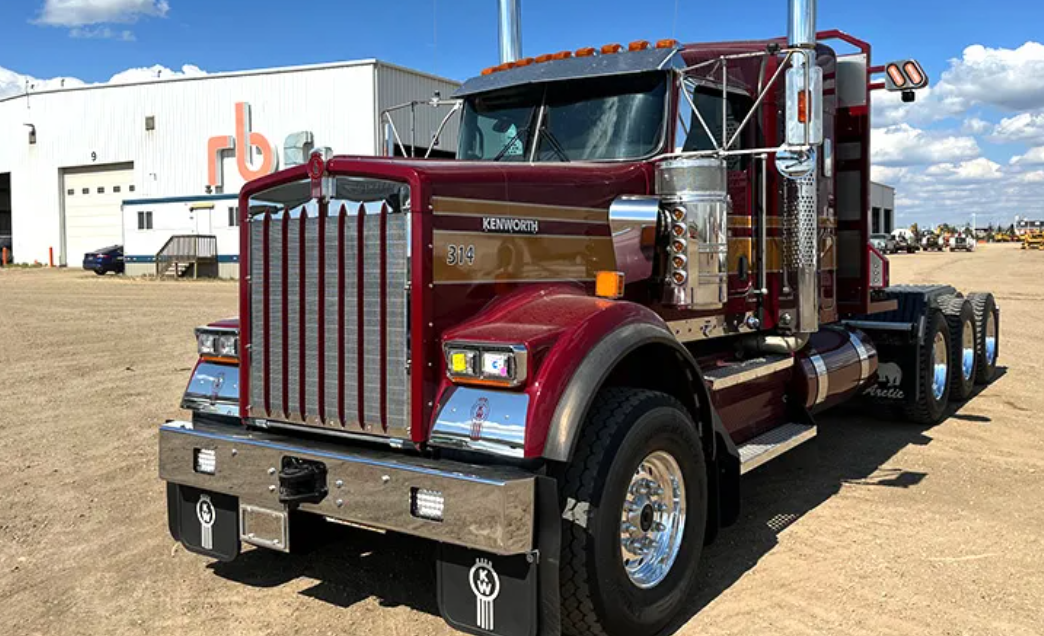WRITTEN BY: BLOOM SERVICES

Are you thinking about leasing a semitruck but feeling a bit overwhelmed by what’s involved? You’re not alone. Leasing can be a smart move, especially if buying one outright isn’t in the cards right now. But let’s be real: it can get pretty confusing with all the requirements and fine print. This article will walk you through everything you need to know – from the nitty-gritty of financial qualifications to the ins and outs of insurance and maintenance.
Whether you’re a business owner in trucking or just starting, this article is your friendly guide to understanding the leasing process. So, let’s dive in and demystify the whole thing together. By the end, you’ll know how to lease a semitruck with the utmost confidence!
What Does it Mean to Lease a Semitruck?
Not all rental and lease-purchase programs are the same, but leasing a semitruck is a bit like renting an apartment but for the road. When you lease a semi, you’re essentially borrowing it for a set period of time. You don’t own the truck, but you get to use it as if it were yours. This means you pay a monthly or weekly fee to the leasing company, which is usually less than what you’d pay if you bought the truck. The lease agreement will spell out how long you can use the truck, the mileage limits – if any, and other important details like maintenance responsibilities. It’s a popular option for many truckers because it allows you to get behind the wheel of a newer model without the hefty price tag of buying one. Plus, at the end of the lease, you often have the choice to buy the truck, trade it in for a newer model, or simply walk away. It’s a flexible way to manage your business expenses and keep your options open. At Bloom we call this lease a rental agreement, to separate it from our lease-purchase program.
Buying vs Leasing a Semitruck
Should you buy your own semitruck or lease one? It’s like choosing between buying a house or renting an apartment, each with its own perks and quirks. If you’re leaning towards buying, you’ll have your very own truck, no strings attached. You can customize it, drive it as much as you like, and it’s all yours once you’ve paid it off. But remember, it’s a pretty hefty chunk of change upfront and a long-term commitment. In general terms, renting or leasing a truck doesn’t require as much upfront and no long-term commitments, but you will never own the truck outright. There are pros and cons to each option. In this section, we will dive into both sides – buying and leasing – so you can figure out which one fits your life on the road better. Let’s get rolling and find out what’s best for you!
Financing a Semitruck
One of the top reasons to finance a semitruck is to own it, but your ability to buy a semitruck boils down to having good credit. If you have bad credit, it will be nearly impossible to finance a truck. Semitrucks are expensive pieces of equipment, brand new trucks cost about $190-200,000 for base models. Even if you do get approved with fair credit, the interest rates will be high. The loan terms for semitrucks are typically anywhere from 12-96 months. Not to mention you will need a hefty down payment for a new truck. Monthly payments for a new semitruck would run about $3700 to $5000 a month depending on interest rates and loan terms and other factors.
If you can handle the hefty up-front costs, the benefit of buying a truck is the long-term profits. After paying off the truck you will be able to continue using it well without a truck note. With full ownership, you have no restrictions on when and if you trade it in, modify it, or sell it. You also won’t have limits on how many miles you can run, but you will be responsible for maintenance and after 500,000 miles maintenance costs may increase. When dealing with conventional semitruck loads, you bear the responsibility for payments whether the truck is operational or not. Ownership brings both risks and rewards that should be carefully considered.
Leasing a Semitruck
Leasing a semitruck is always a good option if you cannot deal with the upfront costs of buying one. Most leases are for newer equipment, and while some leases require credit checks, it is not as much of a barrier to those with poor or bad credit. It offers a bit of financial flexibility, due to not affecting your overall debt level. Some term leases offer the option to purchase the semitruck at the end of its term, others do not, or have huge balloon payments to do so. Also, many leases require the trucker to pay for maintenance during the term of the lease or limit how many miles you are allowed to run the truck. Last but not least, some leasing companies require down payments as well.
However, not all lease terms or leasing companies are the same. At Bloom, we offer a rental program – typically called a lease program. Our rental program varies from other programs in a few ways. However, we will discuss how we are different a bit later in this article.
Requirements for Leasing a Semitruck
At this point you should be fairly familiar with the general difference between buying and leasing a semitruck, let’s discuss the general requirements:
Experience and a Class A CDL
First and foremost, it is essential for individuals looking to lease a semitruck to have a Class A CDL. Also, it is recommended you have a few years of experience under your belt, many companies require at least one to two years of experience to enter a lease or rental program.
Credit Score
While here at Bloom we do not require credit checks, some companies do. Having good credit is better than having bad credit. Some leases charge more for having bad credit. And credit scores lower than 600 may disqualify you from leasing a semitruck. Just like buying a truck, having a good credit score comes in handy. So, if you don’t have great credit or have bad credit, many companies may not even consider you.
Driving Record
Having a good driving record is always a good idea. Being free of accidents, moving violations, and clearinghouse violations help to improve your chances of getting into a semitruck. But, if you have a few violations, it might prevent a leasing company from considering you. It is all about risk mitigation for leasing companies, so fewer violations mean more options. Don’t fret about a speeding ticket here and there but take special care of your driving record, it matters more than you might think.
Financial Considerations for Leasing a Semitruck
In this section, we will break down the financial considerations for leasing a semitruck. To get down to the brass tacks, your ability to secure a semitruck lease with most companies will be influenced by your credit scores and proof of income. Additionally, down payments will vary based on your credit score, with a lower down payment accompanying a higher credit score. On average, individuals with scores above 750 may face down payments ranging from 5% to 10%. However, for those with lower credit scores, the down payment could be as high as 30%. This means that if you opt for a lease or rental program, you might need to put down anywhere from $10,000 to $50,000 for a truck, coupled with a commitment period of 2 to 3 years, even if purchasing the truck at the end is uncertain.
Leasing Fees
The higher the down payment the lower the lease payments for the semitruck. Some companies charge weekly, and others charge monthly, but the range for rental and lease trucks runs between $850 to $1700 a week depending on the make and model. If you can put more down, you can reduce the lease costs. Also, many leases have additional costs beyond the truck. Many companies require the trucker to have their own insurance during the lease program.
Insurance
With many companies, a huge chunk of your monthly spending will go towards insurance. Here is a quick rundown of the different types of insurance you need to carry with most companies. These are just ballpark figures – your mileage may vary.
General Liability Insurance
What it covers: It covers general damage to the semitruck and or injuries.
Rough Costs: Expect it to run anywhere from $6,000 to $16,000 a year.
Physical Damage Insurance
What it covers: This covers additional dings and dents on the leased semitruck
Rough Costs: This will cost about $2,000 to $4,000 a year.
Cargo Insurance
What it covers: It generally covers any damage to the freight you haul.
Rough Costs: This generally will run you $800 to $2,000.
Bobtail Liability
What it covers: It covers times when you are off duty without a trailer attached.
Rough Costs: It will cost you about $400-600 a year.
Gap Insurance
What it covers: If your truck is totaled, it covers the general fair market value of the truck.
Rough Costs: Costs may vary, but they can be anywhere between $1,000 to $3,500 a year.
Insurance costs for a lease or rental program at many companies will be a significant chunk of change. Expect to spend somewhere within the range of $10,200 to $26,100 a year. In addition to insurance, some companies charge for maintenance as well in addition to the rental or lease costs.
Maintenance
Maintenance is important and things will occasionally break on a semitruck. Even preventive maintenance will add to the cost of a rental or lease program. Many lease companies do not include maintenance and that leaves you responsible for all maintenance on the semitruck. The average maintenance cost on a semitruck is around $8,000 to $12,000 a year not including major repairs. Let’s quickly go through some of the most common truck repairs and maintenance you will likely need to run the truck and know how to avoid them.
Tire Blowouts: These are fairly common, mainly because of the heavy loads trucks carry. The trick to avoiding them? Keep an eye on your tires. Regular checks, keeping the right tire pressure, and swapping out old tires are key.
Brakes: With all that weight you’re hauling, your brakes are under a lot of stress. Regular brake inspections and maintenance are super important to prevent any scary brake-related surprises.
Oil Leaks: These can be nasty. An oil leak means parts of your truck start rubbing together without enough lubrication, which can mess up a lot of things. Staying on top of routine maintenance is your best bet to catch and fix any leaks before they become big problems.
Suspension: Ever feel like your truck is shaking more than it should? Might be a suspension issue. Regular pre-inspections and diagnostic checks can help you spot and sort out suspension problems early.
Even if you stay on top of maintenance and do proper checks, your truck still might need major repairs, and hopefully, they fall under the warranty. However, in many rental and lease programs, you may be responsible for all the maintenance for your leased semitruck.
Fuel
As a truck driver, in a lease or rental program, you will need to pay for your own fuel. While managing fuel and budgeting for it might seem difficult, it can be managed. Diesel prices vary from state to state and month to month. It is important to manage your fuel wisely. But you can’t drive without it so it is better to be prepared.
There are two ways, you can generally budget for fuel. One way is to simply use the following formula:
Fuel Cost = (Miles/ Fuel Efficiency) * Fuel Price
Using this method, you could roughly estimate fuel cost per mile.
However, here is a quick, but dirty number you could use to estimate the cost per mile: $0.55 per mile. Keep in mind, that the cost of fuel changes all the time in our economy, and fuel efficiency can vary based on factors such as your load, driving habits, and idling time. However, once you’ve been on the road long enough, you’ll generally have a good sense of the distance your truck can cover on a single tank.
To calculate the per-mile fuel cost for the week use the following formula:
Fuel cost per mile = Fuel cost total/ Miles
So, if you average 3,500 miles per week, you could expect to have spent $1,925 for fuel or $0.55 a mile.
When covering fuel expenses, you may use either your personal fuel cards or those provided by the company you drive for. It’s important to note that obtaining your own fuel card often necessitates good credit or may involve deposits in many cases.
Process of Leasing a Semitruck
The process of leasing a semitruck is fairly straightforward. First, you will need to find a leasing company. You will need to do a bit of homework here, but you are looking for one with good reviews and fair terms. Once you’ve picked one, you will need to reach out to them and discuss their requirements and some costs, etc. Once you have narrowed it down, you will need to agree to the lease terms, mileage limits, and what happens at the end of the lease. If you’re all set, sign and hit the road. Fairly simple, but since leasing companies vary and work differently from company to company.
Certain companies exclusively offer truck leasing services, while others provide rental and lease options with dispatch services. However, if you opt for the latter, you’ll typically need to lease under their authority. In this arrangement, the company will handle dispatch and provide loads, offering support by facilitating the runs. It’s important to note that, under this setup, you won’t have the flexibility to book loads through other companies. While the distinction may seem subtle, the key idea revolves around the level of control and independence in load booking.
When you lease a truck from a company, you typically have the freedom to book loads with anyone.
Leasing a truck with a company often means you work with a company, lease a truck from them, and move their freight exclusively under their authority or the loads they book. However, you likely will not be officially employed with that company, you will be considered an independent contractor.
How does a Semitruck Lease agreement work?
In the simplest terms, a semitruck lease agreement is a rule book for renting a truck. It outlines each side’s responsibilities and expectations. The details are often written in legalese but are generally designed to protect both sides legally. It will provide details such as mileage limits, responsibilities for maintenance, turning in the truck, inspections, and other obligations. It also outlines the obligations of the company you are leasing from as well.
It also details how to separate if you are not satisfied with the rental or leased semitruck. It also outlines payment obligations and determines what you can and cannot do with the leased semitruck. Lease agreements are legally binding, if you agree with the lease terms and sign, you are obligated to live up to your end of the lease terms and the company also is obligated to live up to their end. If you do it right and find the right company, leasing a semitruck can be a sweet deal without the huge costs of buying a truck outright.
Bloom Services Offers Semitruck Leasing with $0 Down
Here at Bloom, we call our lease program a rental program. It is akin to other companies, but there are key differences. First, let’s review some of our requirements and terms.
We, like other companies, require two years of Class A CDL experience. In the beginning, you will be renting the truck and leasing on with us, so you will be running under our authority as an independent contractor. So, all loads will be exclusively dispatched through us, but that is a good thing for many people on the road towards becoming an owner-operator. We pay well and will make sure you get more than enough loads and miles to make money.
We also require that you be prepared to stay on the road for three consecutive weeks. This requirement is essential because we operate as an Over-The-Road (OTR) company, covering all 48 states. To maximize your earnings potential, a minimum commitment of three weeks on the road is necessary.
For our rental program, we don’t do credit checks, nor do we require a down payment, so it’s zero down and no upfront costs. You won’t have to make any payments until your first check. We cover the cargo and liability insurance, meaning all you would only be responsible for the truck, fuel, and a few other smaller weekly expenses.
Under the rental program, the maintenance is included, so all the oil changes, breakdowns, and tires we change in the shop are included. We provide the trailer as well, at no additional charge.
For fuel, we provide two fuel cards, one for Flying J and Pilot and one for Fuel Comdata. You will be able to fuel anywhere you want, you can also use your own fuel card if you have one already.
We pay 82% gross load, which means if the truck gross is $10,000 a week, your cut is $8,200. Out of your cut, you will pay the truck rent, fuel, def, tolls, trailer and truck PHD – physical damage – and what is left over would be your net. Our drivers’ average take-home after expenses are $2,700 to $3,500 a week, but it does depend on how many miles and loads you can handle. If you are worried about getting enough miles, don’t, we will make sure you have all the miles you can handle and then some.
Lease-Purchase a Semitruck with Bloom Services
Bloom Services we have a lease-purchase program as well. We’ve put a lot of thought into making this program something special. It’s not just about driving; it’s your chance to own your semitruck in a reasonable amount of time while making some solid cash.
In the lease-purchase program, like the rental program, you will be responsible for fuel, truck payments, etc. But in addition to those expenses, you will need to have bobtail insurance and you will be responsible for the maintenance. Also, there are no deposits for lease-purchase trucks over 100,000 miles. There might be one for trucks under 100,000 miles, but we can help with that as well.
Our lease program is a straightforward three-year journey. Stick with it, and at the end, that truck you’ve been driving? It’s all yours, no annoying balloon payments. We know owning your truck is a big dream for many, and we’re here to make it come true.
In a nutshell, our lease purchase program is a thoughtfully crafted opportunity. It’s perfect for drivers who are serious about leveling up their trucking game and want to move towards owning their truck. Ready to hit the road with us? Want to know more about how to lease a semitruck? Contact us today or give us a call–let us get you out on the road.



office & Parking depot
5120 Belmont Rd Unit K, Downers Grove, IL 60515, USA
Hours of operation
Mon - Sun: 7am-5pm
